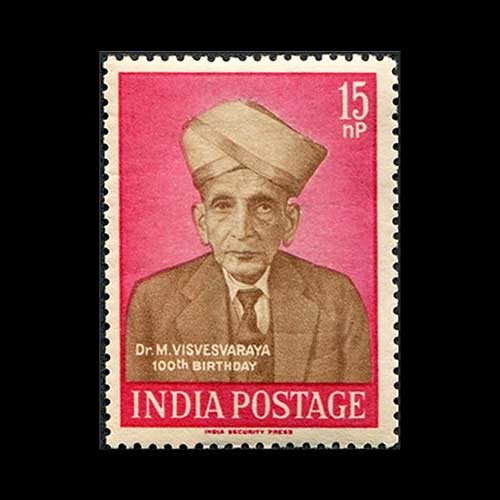Science and Technology on Indian Postage Stamps-6
2025-11-12 Wed
Sir Mokshagundam Visvesvaraya is regarded as one of India's most distinguished engineers. His innovative contributions to #Engineering have significantly transformed the nation's Infrastructure through visionary designs and meticulous planning.Born on 15 September 1861 at Muddenahalli, in the Princely State of Mysore (Karnataka), his birthday is celebrated annually as Engineer's Day in India, as well as in SriLanka and Tanzania. Visvesvaraya, often referred to as the ‘Father of Modern Mysore State,’ pursued a degree in Civil Engineering at the college of Science, now known as the College of Engineering, Pune. At the age of 22, he began his career in the Public Works Department (PWD) of the government of Bombay as an Assistant Engineer, where one of his initial projects involved constructing a pipe siphon across a channel of the Panjra River. A siphon pipe is a bent tube that transfers liquid from a higher reservoir to a lower one using gravity and atmospheric pressure.
Among his noteworthy accomplishments are the introduction of the block system of irrigation in the Deccan canals in 1899, the resolution of water quality issues in the city of Sukkur along the Indus River, and the invention of automatic gates designed to regulate water flow in reservoirs, which he successfully patented.
In 1909, he joined the Mysore Service as chief engineer, eventually ascending to the role of Dewan of Mysore. In this capacity, he was instrumental in the establishment of the University of Mysore in 1916. After voluntarily retiring from state service in 1918, he continued his contributions, particularly to the Mysore Iron and Steel Works, and founded the Sri Jayachamarajendra Occupational Institute in Bangalore in 1943, later renamed Sri Jayachamarajendra Government Polytechnic. This institution was established to provide specialized Training for technicians in anticipation of India's #industrial Growth. Additionally, he authored four influential works: ‘Reconstructing India’ (1920), ‘Unemployment in India: its causes and cure’ (1932), ‘Planned Economy of India’ (1934) and ‘Memories of my working life’ (1951),
In recognition of his exceptional service to both the Princely State of Mysore and the Republic of India, he was awarded the prestigious Bharat Ratna by the Government of India in 1955. On 15 September 1960, India #post honored his legacy by issuing a commemorative postage #stamp featuring him, with a face value of 15np, coinciding with his #birth centenary. This stamp marked one of the earliest instances of a postage stamp being issued to honor a living individual!
Latest News
-
Science and Technology on Indian Postage Stamps-5
2025-11-11 TueSir Jagadish Chandra Bose recognized as India's first biophysicist was born on 30 November 1858, in ...
-
'Al-Sultan' Type Copper Double Falus of Malwa Sultan Ghiyath Shah
2025-11-07 FriAnother type of Copper Double Falus of Malwa Sultan Ghiyath Shah, weighing 17.5-18.1g. <br><br> I...
-
Science and Technology on Indian Postage Stamps-4
2025-11-07 FriThe last stamp in the series issued by India Post on 11 September 1997, to commemorate the 50th anni...
-
Science and Technology on Indian Postage Stamps-3
2025-11-06 ThuThe next #stamp in the series issued by #India #post on 11 #September 1997 commemorates the 50th an...
-
Science and Technology on Indian Postage Stamps-2
2025-11-05 WedIn continuation of the stamp series issued by India Post on 11 September 1997, to celebrate the 50th...

